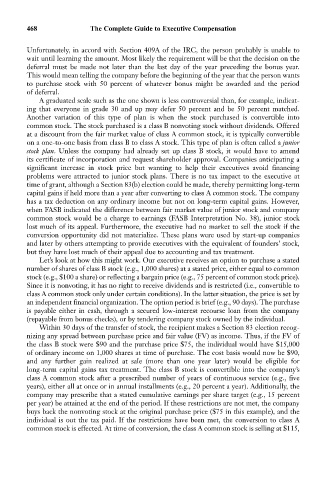Page 482 - Bruce Ellig - The Complete Guide to Executive Compensation (2007)
P. 482
468 The Complete Guide to Executive Compensation
Unfortunately, in accord with Section 409A of the IRC, the person probably is unable to
wait until learning the amount. Most likely the requirement will be that the decision on the
deferral must be made not later than the last day of the year preceding the bonus year.
This would mean telling the company before the beginning of the year that the person wants
to purchase stock with 50 percent of whatever bonus might be awarded and the period
of deferral.
A graduated scale such as the one shown is less controversial than, for example, indicat-
ing that everyone in grade 30 and up may defer 50 percent and be 50 percent matched.
Another variation of this type of plan is when the stock purchased is convertible into
common stock. The stock purchased is a class B nonvoting stock without dividends. Offered
at a discount from the fair market value of class A common stock, it is typically convertible
on a one-to-one basis from class B to class A stock. This type of plan is often called a junior
stock plan. Unless the company had already set up class B stock, it would have to amend
its certificate of incorporation and request shareholder approval. Companies anticipating a
significant increase in stock price but wanting to help their executives avoid financing
problems were attracted to junior stock plans. There is no tax impact to the executive at
time of grant, although a Section 83(b) election could be made, thereby permitting long-term
capital gains if held more than a year after converting to class A common stock. The company
has a tax deduction on any ordinary income but not on long-term capital gains. However,
when FASB indicated the difference between fair market value of junior stock and company
common stock would be a charge to earnings (FASB Interpretation No. 38), junior stock
lost much of its appeal. Furthermore, the executive had no market to sell the stock if the
conversion opportunity did not materialize. These plans were used by start-up companies
and later by others attempting to provide executives with the equivalent of founders’ stock,
but they have lost much of their appeal due to accounting and tax treatment.
Let’s look at how this might work. Our executive receives an option to purchase a stated
number of shares of class B stock (e.g., 1,000 shares) at a stated price, either equal to common
stock (e.g., $100 a share) or reflecting a bargain price (e.g., 75 percent of common stock price).
Since it is nonvoting, it has no right to receive dividends and is restricted (i.e., convertible to
class A common stock only under certain conditions). In the latter situation, the price is set by
an independent financial organization. The option period is brief (e.g., 90 days). The purchase
is payable either in cash, through a secured low-interest recourse loan from the company
(repayable from bonus checks), or by tendering company stock owned by the individual.
Within 30 days of the transfer of stock, the recipient makes a Section 83 election recog-
nizing any spread between purchase price and fair value (FV) as income. Thus, if the FV of
the class B stock were $90 and the purchase price $75, the individual would have $15,000
of ordinary income on 1,000 shares at time of purchase. The cost basis would now be $90,
and any further gain realized at sale (more than one year later) would be eligible for
long-term capital gains tax treatment. The class B stock is convertible into the company’s
class A common stock after a prescribed number of years of continuous service (e.g., five
years), either all at once or in annual installments (e.g., 20 percent a year). Additionally, the
company may prescribe that a stated cumulative earnings per share target (e.g., 15 percent
per year) be attained at the end of the period. If these restrictions are not met, the company
buys back the nonvoting stock at the original purchase price ($75 in this example), and the
individual is out the tax paid. If the restrictions have been met, the conversion to class A
common stock is effected. At time of conversion, the class A common stock is selling at $115,

